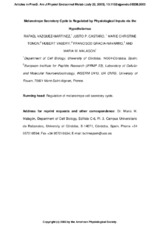Melanotrope Secretory Cycle is Regulated by Physiological Inputs via the Hypothalamus
Autor
Vázquez Martínez, Rafael
Castaño, Justo P.
Tonon, Marie Christine
Vaudry, Hubert
Gracia-Navarro, F.
Malagón, María M.
Fecha
2017-03-17Materia
DopamineMelanotrope cell heterogeneity
NPY
Secretory cycle
TRH
METS:
Mostrar el registro METSPREMIS:
Mostrar el registro PREMISMetadatos
Mostrar el registro completo del ítemResumen
Previously, it has been shown that background color conditions regulate the
overall activity of the frog intermediate lobe by varying the proportions of the
two subtypes of melanotropes existing in the gland, the highly active or
secretory melanotropes and hormone-storage melanotropes, depending on
melanocyte-stimulating hormone ( -MSH) requirements. However, the factors
and mechanisms underlying these background-induced changes are still
unknown. In the present study, we investigated whether hypothalamic factors
known to regulate melanotrope cell function can induce changes in vitro similar
to those caused by background adaptation in vivo. We found that the inhibitors
apomorphine (a dopamine receptor agonist) and NPY decreased the number of
active melanotropes and increased simultaneously that of storage
melanotropes. On the other hand, the stimulator TRH increased the number of
active cells and concomitantly reduced that of storage cells. Inasmuch as none
of these treatments modified the apoptotic and proliferation rates in
melanotrope cells, it appears that these hypothalamic factors caused actual
interconversions of cells from a subpopulation to its counterpart. When taken
together, these findings suggest that the hypothalamus would control
melanotrope activity not only through short-term regulation of hormone
synthesis and release, but also through a long-term regulation of the secretory
phenotype of these cells whereby the activity of the intermediate lobe would be
adjusted to fulfill the hormonal requirements imposed by background
conditions.

